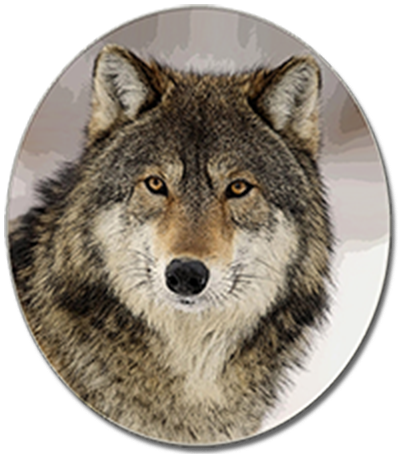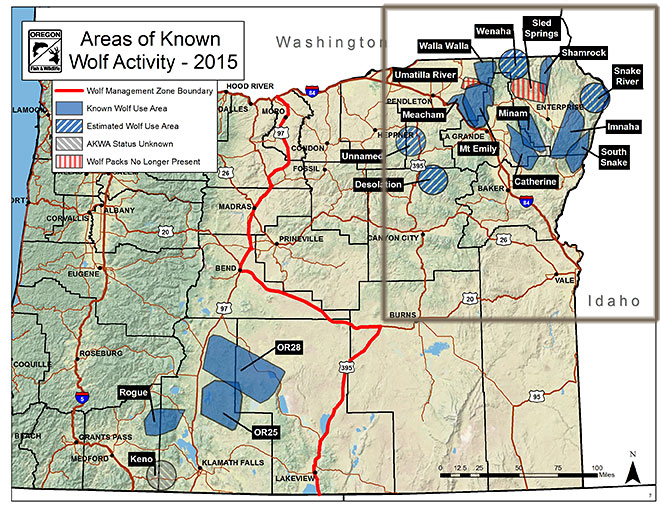Gray Wolf
 The gray wolf - Canis lupus - was once common throughout all of North America, but was exterminated by the 1930s in the U.S. Wolves were hunted for bounty and poisoned with extensive use of strychnine. In a final effort to effect wolf extermination in the U.S., in 1905 Montana required a state veterinarian to capture wolves and coyotes, infest them with sarcoptic mange, and then release them back into the wild to spread the deadly parasitic disease. 6
The gray wolf - Canis lupus - was once common throughout all of North America, but was exterminated by the 1930s in the U.S. Wolves were hunted for bounty and poisoned with extensive use of strychnine. In a final effort to effect wolf extermination in the U.S., in 1905 Montana required a state veterinarian to capture wolves and coyotes, infest them with sarcoptic mange, and then release them back into the wild to spread the deadly parasitic disease. 6
Wolves were reintroduced into the Yellowstone ecosystem in 1995. Fourteen wolves, genetically similar to the original U.S. wolves, from many separate packs, were captured in Canada for eventual release in the Yellowstone ecosystem.
Those who oppose wolf recovery tell tall tales of a giant and especially vicious strain of wolves said to have been used for reintroduction. However, wolves are well known for dispersing long diestances from their birth sites; wolves from the northernmost U.S. states commonly mixed with those of southern Canada. "Recent genetic research involving hundreds of wolves sampled from Idaho, Montana, and Wyoming in the 1990s and 2000s found no evidence that the remnant native population of wolves differed from the reintroduced wolves. Thus, the wolves present in these states before wolf recovery began were genetically similar to those used in reintroductions into Yellowstone." 5
Gray wolves may vary in color from a tawny gray, black, or white, including combinations of those colors. The gray wolf an extremely close relative of our domesticated dogs. Studies show the mitochondrial DNA variance between wolf and dog is, at most, 0.2% of mitochondrial DNA squence. In fact, wolves differ from their closest wild relative, the coyote, by about 4% of mitochondrial DNA sequence - telling us that wolves are far more closely related to our pet dogs than to coyotes! 1 Prof Robert K. Wayne explains, "Dogs derived from ancient wolves that inhabited Europe and are now extinct. The wolf is the first domesticated species and the only large carnivore humans ever domesticated." 2,3
General physical comparisons between wolf and dog
The average weight of an adult gray wolf male ranges between 70 and 110 pounds while female weights range between 60 and 90 pounds. Compare this to the average weight of a German Shepherd dog: 75 - 95 pounds.
A wolf's head is significantly larger in comparison to their body size than most dogs because wolves have larger brains. Wolves have very long legs which allow them to run at high speeds over great distances and large paws that make travel easier in snow or sand. Wolves' chests and hips are narrow, while dogs have wide hips and chests with fairly short legs in comparison to their body size.
The biggest difference between our pet dogs and wolves is that our dogs never develop to the mental state of a 30 day old wolf puppy. A mature wolf is very independent and possesses an instinctive social complexity that is far beyond that of any dog. Even wolves rescued as pups and raised by humans are more complex in nature than dogs though they were never exposed to the teaching of a wolf pack. Wolves are not pets. Those who wish to have a wolf as a pet should consider a German Shepherd or Husky instead! 4
Ecosystem balance
Wolves help keep ungulate (hoofed mammal) populations heathy by keeping their numbers in check, most often preying upon the weak because those are the safest targets. Taking down a large deer or elkputs the pack members' lives in danger from sharp antlers and/or hooves.
 The gray wolf was endangered in the western two thirds of Oregon until November 10, 2015 when ODFW decided that 110 wolves were enough to declare the species recovered in the entire state. The reason that the gray wolf did not warrant an endangered status in the eastern parts of Oregon is in that area, wolves are dispersing into Oregon from Idaho.
The gray wolf was endangered in the western two thirds of Oregon until November 10, 2015 when ODFW decided that 110 wolves were enough to declare the species recovered in the entire state. The reason that the gray wolf did not warrant an endangered status in the eastern parts of Oregon is in that area, wolves are dispersing into Oregon from Idaho.
ODFW tells us that as of 2015, there were 15 wolf packs, 5 wolf pairs, and 4 lone wolves in the state. (An update of that information must acknowledge the state killing of OR-4, his mate, and two pups - originally from the Rogue wolf pack. 8) Of those 15 wolf packs, only one - the Rogue pack - was listed outside the Oregon/Idaho area in the northeast corner of Oregon.
Current thrests
Ultimately, humans are the biggest threat to wolf recovery via habitat loss, diminishing protections, and trophy hunting. Where wolves are protected, the infrequent issue of livestock predation almost always results in the death of entire wolf packs. This is the case even when predation occurs after a rancher has moved cattle into known wolf territory on a public lands grazing lease!
Where wolves are not protected, trophy hunts and poaching take many lives. As of April 2016, over 4,200 wolves have been killed by hunters and trappers in only six states! 7
Quick facts
- Average height: 26 - 32 inches at the shoulder.
- Average weight: Females - 60 to 90 pounds / Males - 70 to 110 pounds
- Average lifespan in the wild: 6 - 8 years, up to 13 years
- Number of teeth: 42
- Breeding season: February - March
- Litter size: 4 - 6 pups
- Age at maturity: 2 years
- Wolves are social animals, preferring to live in groups called packs.
- Average pack size: 5 to 8, but maximum pack size can be as high as 30
- Pack territory size: between 25 and 150 square miles, depending on availability of game. Typically 13 -20 miles.
- Movement speed: Average - 5 mph / Sprinting - up to 38 mps, for short distances
- Diet: Ungulates like deer, elk, caribou, bison, and moose, but also smaller animals such as beaver or rats
Sources
1. “The domestic dog is an extremely close relative of the gray wolf, differing from it by at most 0.2% of mtDNA sequence…In comparison, the gray wolf differs from its closest wild relative, the coyote, by about 4% of mitochondrial DNA sequence.” Wayne, Robert K. "“Molecular evolution of the dog family”." Theoretical and Applied Genetics.3. Verginelli, Fabio, Cristian Capelli, Valentina Coia, and Raffaele Palmirotta. "Mitochondrial DNA from Prehistoric Canids Highlights Relationships Between Dogs and South-East European Wolves." Molecular Biology and Evolution. Oxford Journals, n.d. Web. 3 Jan. 2016. <http://mbe.oxfordjournals.org/content/22/12/2541.full>.
4. "Education vs Extinction." Mission: Wolf. N.p., n.d. Web. <http://missionwolf.org/page/wolf-dog-difference/>.
5. "Gray Wolf Conservation and Management." WDFW - Washington Department of Fish & Wildlife, n.d. Web. <http://wdfw.wa.gov/conservation/gray_wolf/faq.html>.
6. Stark, Mike. "Disease Used to Help Wipe out Wolves Century Ago Plagues Animals Today." Mange in the Mountains. Billings Gazette, 4 Mar. 2007. Web. <http://trib.com/news/state-and-regional/mange-in-the-mountains/article_5d617195-fb0f-5ce5-bdf1-6e7dfdb4b11e.html>.
7. "Predator Defense - Protecting Wolves at Risk." Predator Defense - a National Nonprofit Helping People & Wildlife Coexist Since 1990, www.predatordefense.org/wolves.htm#Rockies.
8. "Wildlife officials shot OR4, his mate, and two offspring after the pack had killed livestock." Oregon’s Legendary Wolf Killed, TakePart, www.takepart.com/article/2016/04/02/oregon-just-killed-family-wolves. Accessed 6 Apr. 2016.
